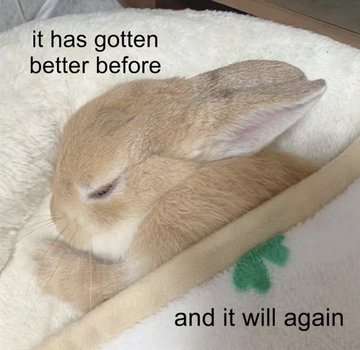

He wants to know who the US president is.


He wants to know who the US president is.
IDGI
Explanation?


People are asking a lot of questions that are already answered by my ‘I wouldn’t eat a human’ shirt.


What’s the point of getting a PS5 or Xbox instead of a PC?


Synonyms for the word ‘Cassandra’ include ‘tankie’.


I’m being serious. The word ‘infinity’ refers to some points from spaces like Aleksandrov compactification. It does not refer to any sort of repetition of any pattern. You cannot, for example, write ‘0.999∞’ or ‘0.999infinity’ to mean the same thing as ‘0.999…’ or ‘0.(9)’.


Alright, so, the other proof that I promised:
If we define 0.999… as the sum of the series 9/10+9/100+9/1000+…, then for every neighbourhood U(1) it is true that there exists a metric ball B_N = B(1, 1/10^N), where N is natural, such that B_N is a subset of U(1).
For all natural n > N it is true that d(sum(9/10^k) for k from 1 to n, 1) = |1 - sum(9/10^k) for k from 1 to n| = |1/10^n| = 1/10^n < 1/10^N, meaning that for all natural n > N it is true that sum(9/10^k) for k from 1 to n is in B_N, meaning that it is also in U(1).
However, sum(9/10^k) for k from 1 to n is the nth partial sum of the series 9/10+9/100+9/1000+…, which, together with the fact that every such sum is in U(1) for n > N, means that 1 is the limit of the sequence of the partial sums of the series 9/10+9/100+9/1000+…, meaning that 1 is the sum of that series. That means that 0.999… is 1 by definition.


Thank you.
And no, I do not notice any errors.
I should re-learn Lateχ.


The ellipses mean infinity
No, it does not. The ellipsis notation is used to denote a repeating pattern. It is not used to denote points that are named ‘infinity’ in spaces like Aleksandrov compactification and the extended space of real numbers.
I am sorry, but your reply lacks rigour.


The symbol ‘i’ is usually reserved for the imaginary unit.


Just to be specific, as what a particular sequence converges to depends on the topology of the space where we are looking for a limit of the sequence. Hell, in non-Hausdorff spaces a sequence can have multiple limits (trivial case: anti-discrete space of cardinality greater than 1 will have every sequence converge to every point in it).


Turns out, dragons are kind of cool.


I am going to note that this was not well-expressed when you said ‘we can just pretend to have “reached infinity” and work with like any number’. To a lay person it would look as if you were suggesting that we non-rigorously treat one object (like the sequence (0.9, 0.99, 0.999,…)) as another (like the real number that that sequence converges to given the standard topology of the space of real numbers).


Yeah that’s something that people have to get used to in maths, if the limit of a sequence exists we can just pretend to have “reached infinity” and work with like any number
I’m not sure what you are trying to say here, and I have a background in math. I think this is just going to confuse lay people.


I will be posting another another proof, one using the assumption that 0.999… is the sum of the series 9/10+9/100+9/1000+… (and that 1 is the sum of the series 1+0+0+0+…), unless somebody else comes here and feeds it to the little guy first.


Four more years!


And like he also said, ‘Pause’.


A real number can’t be approaching anything. It is not a function or any other sort of object that can be said to be approaching anything.
But what’s the significance?